GCSE Tutoring Programme
"Our chosen students improved 1.19 of a grade on average - 0.45 more than those who didn't have the tutoring."
In order to access this I need to be confident with:
Multiples Simplifying fractions Equivalent fractions Mixed number to improper fraction Lowest common multipleThis topic is relevant for:

Adding And Subtracting Fractions
Here we will learn about adding and subtracting fractions, including when the fractions have the same denominator, when they have different denominators and when they are mixed numbers.
There are also adding and subtracting fractions worksheets based on Edexcel, AQA and OCR exam questions, along with further guidance on where to go next if you’re still stuck.
What is adding and subtracting fractions?
Adding and subtracting fractions is the skill of ensuring the fractions in a calculation have common denominators so that the addition or subtraction can be carried out.
A fraction is a numerical quantity that is not a whole number (integer) but can be expressed as one integer divided by another. The division is represented by a horizontal line.
The integer on the top of the line is called the numerator.
The integer underneath the line is called the denominator.
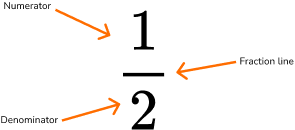
If the fractions within the question have the same denominators already, then the numerators can be easily added/subtracted and the final answer will also have the same denominator.
For example,
\cfrac{5}{7} - \cfrac{2}{7} = \cfrac{5-2}{7} = \cfrac{3}{7}If the fractions within the question have different denominators, we must use equivalent fractions along with knowledge of calculating the lowest common multiple to change the fractions so that they have like denominators.
For example,
\cfrac{3}{5} + \cfrac{1}{10} = \cfrac{3\times 2}{5\times 2} + \cfrac{1}{10} =\cfrac{6}{10} + \cfrac{1}{10} = \cfrac{6+1}{10} = \cfrac{7}{10}Step-by-step guide: Adding fractions
Step-by-step guide: Subtracting fractions
What is adding and subtracting fractions?
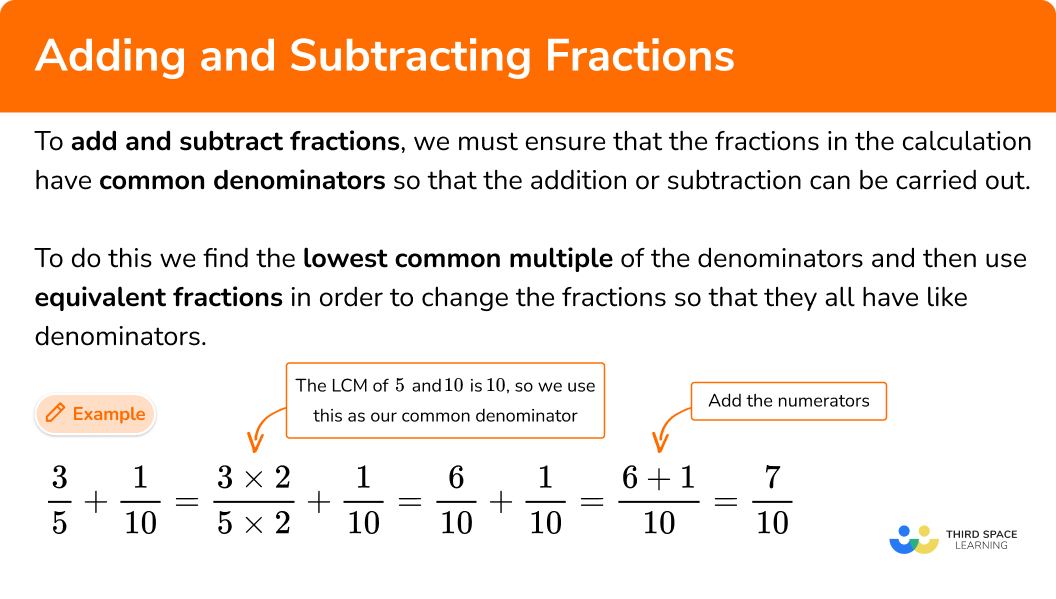
How to add and subtract fractions
In order to add and subtract fractions:
- Ensure the fractions have a common denominator.
- Add or subtract the numerators.
- Write the answer as a fraction in the simplest form.
Explain how to add and subtract fractions
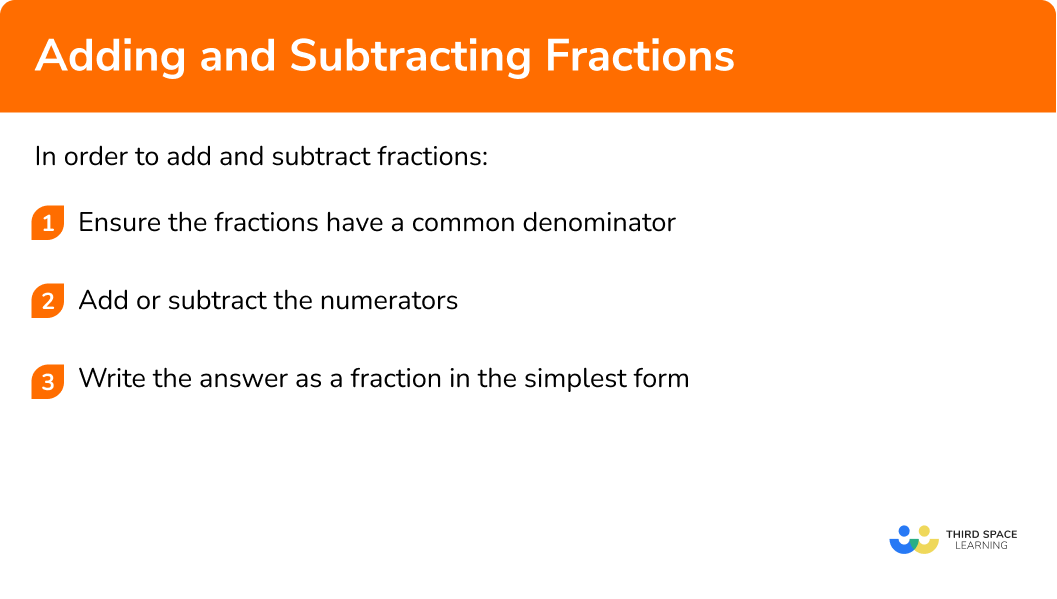

Adding and subtracting fractions worksheet

Get your free adding and subtracting fractions worksheet of 20+ questions and answers. Includes reasoning and applied questions.
DOWNLOAD FREE
Adding and subtracting fractions worksheet

Get your free adding and subtracting fractions worksheet of 20+ questions and answers. Includes reasoning and applied questions.
DOWNLOAD FREERelated lessons on fractions
Adding and subtracting fractions is part of our series of lessons to support revision on fractions. You may find it helpful to start with the main fractions lesson for a summary of what to expect, or use the step by step guides below for further detail on individual topics. Other lessons in this series include:
Adding and subtracting fractions examples
Example 1: adding fractions with a common denominator
Determine the value of \; \cfrac{5}{9}+\cfrac{2}{9}.
- Ensure the fractions have a common denominator.
The fractions have a common denominator of 9.
2Add or subtract the numerators.
\cfrac{5}{9}+\cfrac{2}{9}=\cfrac{5+2}{9}=\cfrac{7}{9}.3Write the answer as a fraction in the simplest form.
7 and 9 do not share any common factors except 1 and so the fraction is already in its simplest form.
The solution is \cfrac{7}{9}.
Example 2: adding fractions where one denominator is a multiple of the other
Determine the value of \; \cfrac{3}{8}+\cfrac{1}{4}.
Ensure the fractions have a common denominator.
These fractions have different denominators, therefore we need to use equivalent fractions to write them with a common denominator. The common denominator we should use will be the lowest common multiple (LCM) of the denominators.
The lowest common multiple of 8 and 4 is 8.
Therefore we only need to use equivalent fractions to change the denominator of the second fraction. We do this by multiplying the numerator and denominator by 2, because 4\times2=8.
\cfrac{1}{4}\times\cfrac{2}{2}=\cfrac{1\times{2}}{4\times{2}}=\cfrac{2}{8}
We now have the two fractions \cfrac{3}{8}+\cfrac{2}{8} both with a common denominator of 8.
Add or subtract the numerators.
Write the answer as a fraction in the simplest form.
5 and 8 do not share any common factors except 1 and so the fraction is already in its simplest form.
The solution is \cfrac{5}{8}.
Example 3: adding fractions with different denominators
Determine the value of \; \cfrac{1}{2}+\cfrac{5}{11}.
Ensure the fractions have a common denominator.
These fractions have different denominators, therefore we need to use equivalent fractions to write them with a common denominator. The common denominator we should use will be the lowest common multiple (LCM) of the denominators.
The lowest common multiple of 2 and 11 is 22.
So we multiply the numerator and denominator of the first fraction by 11 to achieve a denominator of 22.
\cfrac{1}{2}\times\cfrac{11}{11}=\cfrac{1\times{11}}{2\times{11}}=\cfrac{11}{22}
And, we multiply the numerator and denominator of the second fraction by 2 to achieve a denominator of 22.
\cfrac{5}{11}\times\cfrac{2}{2}=\cfrac{5\times{2}}{11\times{2}}=\cfrac{10}{22}
We now have the two fractions \cfrac{11}{22}+\cfrac{10}{22} both with a common denominator of 22.
Add or subtract the numerators.
Write the answer as a fraction in the simplest form.
21 and 22 do not share any common factors except 1 and so the fraction is already in its simplest form.
The solution is \cfrac{21}{22}.
Example 4: subtracting fractions with a common denominator
Determine the value of \; \cfrac{7}{12}-\cfrac{5}{12}.
Ensure the fractions have a common denominator.
The fractions have a common denominator of 12.
Add or subtract the numerators.
Write the answer as a fraction in the simplest form.
2 and 12 share a common factor of 2. Therefore we can divide the numerator and denominator by 2 in order to simplify the fraction.
\cfrac{2}{12}=\cfrac{2\div 2}{12\div 2}=\cfrac{1}{6}
The solution is \cfrac{1}{6}.
Example 5: subtracting fractions where one denominator is a multiple of the other
Determine the value of \; \cfrac{11}{15}-\cfrac{2}{5}.
Ensure the fractions have a common denominator.
These fractions have different denominators, therefore we need to use equivalent fractions to write them with a common denominator. The common denominator we should use will be the lowest common multiple (LCM) of the denominators.
The lowest common multiple of 15 and 5 is 15.
Therefore we only need to use equivalent fractions for changing the denominator of the second fraction. We do this by multiplying the numerator and denominator by 3, because 5\times3=15.
\cfrac{2}{5}\times\cfrac{3}{3}=\cfrac{2\times{3}}{5\times{3}}=\cfrac{6}{15}
We now have the two fractions \cfrac{11}{15}-\cfrac{6}{15} both with a common denominator of 15.
Add or subtract the numerators.
Write the answer as a fraction in the simplest form.
5 and 15 share a common factor of 5. Therefore we can divide the numerator and denominator by 5 in order to simplify the fraction.
\cfrac{5}{15}=\cfrac{5\div 5}{15\div 5}=\cfrac{1}{3}
The solution is \cfrac{1}{3}.
Example 6: subtracting fractions with different denominators
Determine the value of \; \cfrac{5}{6}-\cfrac{7}{9}.
Ensure the fractions have a common denominator.
These fractions have different denominators, therefore we need to use equivalent fractions to write them with a common denominator. The common denominator we should use will be the lowest common multiple (LCM) of the denominators.
The lowest common multiple of 6 and 9 is 18.
So we multiply the numerator and denominator of the first fraction by 3 to achieve a denominator of 18, because 6\times 3=18.
\cfrac{5}{6}\times\cfrac{3}{3}=\cfrac{5\times{3}}{6\times{3}}=\cfrac{15}{18}
And, we multiply the numerator and denominator of the second fraction by 2 to achieve a denominator of 18 because 9\times 2=18.
\cfrac{7}{9}\times\cfrac{2}{2}=\cfrac{7\times{2}}{9\times{2}}=\cfrac{14}{18}
We now have the two fractions \cfrac{15}{18}-\cfrac{14}{18} both with a common denominator of 18.
Add or subtract the numerators.
Write the answer as a fraction in the simplest form.
1 and 18 do not share any common factors except 1 and so the fraction is already in its simplest form.
The solution is \cfrac{1}{18}.
How to add and subtract mixed numbers
In order to add and subtract mixed numbers:
- Convert all mixed numbers to improper fractions.
- Ensure the fractions have a common denominator.
- Add or subtract the numerators.
- Write the answer as a mixed number/fraction in the simplest form.
Explain how to add and subtract mixed numbers
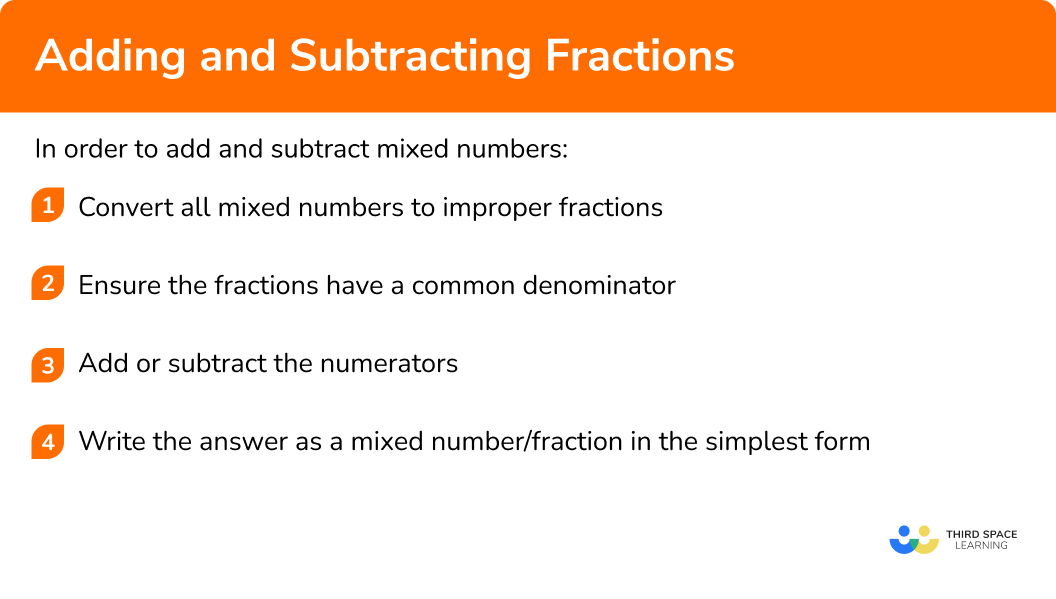
Example 7: adding mixed numbers with different denominators
Determine the value of \; 1\cfrac{3}{4}+2\cfrac{5}{6}.
Convert all mixed numbers to improper fractions.
2\cfrac{5}{6}=\cfrac{(6\times{2})+5}{6}=\cfrac{12+5}{6}=\cfrac{17}{6}
We now have the two fractions \cfrac{7}{4}+\cfrac{17}{6}.
Ensure the fractions have a common denominator.
These fractions have different denominators, therefore we need to use equivalent fractions to write them with a common denominator. The common denominator we should use will be the lowest common multiple (LCM) of the denominators.
The lowest common multiple of 4 and 6 is 12.
So we multiply the numerator and denominator of the first fraction by 3 to achieve a denominator of 12 because 4\times 3=12.
\cfrac{7}{4}\times\cfrac{3}{3}=\cfrac{7\times{3}}{4\times{3}}=\cfrac{21}{12}
We multiply the numerator and denominator of the second fraction by 2 to achieve a denominator of 12 because 6\times 2=12.
\cfrac{17}{6}\times\cfrac{2}{2}=\cfrac{17\times{2}}{6\times{2}}=\cfrac{34}{12}
We now have the two fractions \cfrac{21}{12}+\cfrac{34}{12} both with a common denominator of 12.
Add or subtract the numerators.
Write the answer as a fraction in the simplest form.
55 and 12 do not share any common factors except 1 and so the fraction is already in its simplest form. However, as \cfrac{55}{12} is an improper fraction, we should convert this back to a mixed number for the solution.
55\div 12 = 4 \ (remainder \ 7)
Therefore the mixed number has 4 as a whole number, and 7 remains to be divided by 12, giving 4\cfrac{7}{12}.
The solution is 4\cfrac{7}{12}.
Example 8: subtracting mixed numbers with different denominators
Determine the value of \; 3\cfrac{1}{2}-1\cfrac{2}{3}.
Convert all mixed numbers to improper fractions.
1\cfrac{2}{3}=\cfrac{(3\times{1})+2}{3}=\cfrac{3+2}{3}=\cfrac{5}{3}
We now have the two fractions \cfrac{7}{2}-\cfrac{5}{3}.
Ensure the fractions have a common denominator.
These fractions have different denominators, therefore we need to use equivalent fractions to write them with a common denominator. The common denominator we should use will be the lowest common multiple (LCM) of the denominators.
The lowest common multiple of 2 and 3 is 6.
So we multiply the numerator and denominator of the first fraction by 3 to achieve a denominator of 6.
\cfrac{7}{2}\times\cfrac{3}{3}=\cfrac{7\times{3}}{2\times{3}}=\cfrac{21}{6}
We multiply the numerator and denominator of the second fraction by 2 to achieve a denominator of 6.
\cfrac{5}{3}\times\cfrac{2}{2}=\cfrac{5\times{2}}{3\times{2}}=\cfrac{10}{6}
We now have the two fractions \cfrac{21}{6}-\cfrac{10}{6} both with a common denominator of 6.
Add or subtract the numerators.
Write the answer as a fraction in the simplest form.
11 and 6 do not share any common factors except 1 and so the fraction is already in its simplest form.
As \cfrac{11}{6} is an improper fraction, we should convert this back to a mixed number for the solution.
11\div 6 = 1 \ (remainder \ 5)
Therefore the mixed number has 1 as a whole number, and 5 remains to be divided by 6, giving 1\cfrac{5}{6}.
The solution is 1\cfrac{5}{6}.
Example 9: adding and subtracting mixed numbers with different denominators
Determine the value of \; 4\cfrac{2}{3}+2\cfrac{4}{5}-1\cfrac{5}{6}.
Convert all mixed numbers to improper fractions.
2\cfrac{4}{5}=\cfrac{(5\times{2})+4}{5}=\cfrac{10+4}{5}=\cfrac{14}{5}
1\cfrac{5}{6}=\cfrac{(6\times{1})+5}{6}=\cfrac{6+5}{6}=\cfrac{11}{6}
We now have the three fractions \cfrac{14}{3}+\cfrac{14}{5}-\cfrac{11}{6}.
Ensure the fractions have a common denominator.
These fractions have different denominators, therefore we need to use equivalent fractions to write them with a common denominator. The common denominator we should use will be the lowest common multiple (LCM) of the denominators.
The lowest common multiple of 3,5 and 6 is 30.
We therefore need to determine an equivalent fraction for each of the three fractions with a denominator of 30.
We need to multiply the numerator and denominator of the first fraction by 10 to achieve a denominator of 30.
\cfrac{14}{3}\times\cfrac{10}{10}=\cfrac{14\times{10}}{3\times{10}}=\cfrac{140}{30}
We need to multiply the numerator and denominator of the second fraction by 6 to achieve a denominator of 30.
\cfrac{14}{5}\times\cfrac{6}{6}=\cfrac{14\times{6}}{5\times{6}}=\cfrac{84}{30}
We need to multiply the numerator and denominator of the third fraction by 5 to achieve a denominator of 30.
\cfrac{11}{6}\times\cfrac{5}{5}=\cfrac{11\times{5}}{6\times{5}}=\cfrac{55}{30}
We now have the three fractions \cfrac{140}{30}+\cfrac{84}{30}-\cfrac{55}{30} all with a common denominator of 30.
Add or subtract the numerators.
Write the answer as a fraction in the simplest form.
169 and 30 do not share any common factors except 1 and so the fraction is already in its simplest form.
As \cfrac{169}{30} is an improper fraction, we should convert this back to a mixed number for the solution.
169\div 30 = 5 \ (remainder \ 19)
Therefore the mixed number has 5 as a whole number, and 19 remains to be divided by 30, giving 5\cfrac{19}{30}.
The solution is 5\cfrac{19}{30}.
How to add and subtract mixed numbers (alternative method)
In order to add and subtract mixed numbers:
- Rewrite the calculation separating the whole numbers and the fractions.
- Add or subtract the whole numbers.
- Ensure the fractions have a common denominator.
- Add or subtract the numerators.
- Put the whole number answer and fraction answer together to form a mixed number writing the final answer in the simplest form.
Explain how to add and subtract mixed numbers (alternative method)
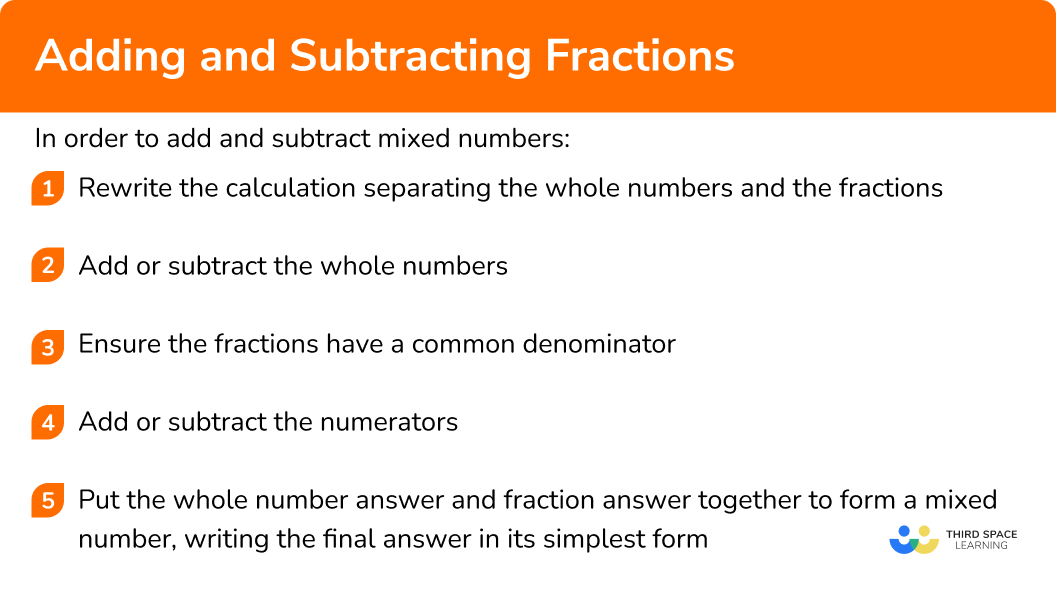
Example 10: adding and subtracting mixed numbers with common denominators
Determine the value of \; 5\cfrac{2}{7}+3\cfrac{4}{7}-4\cfrac{5}{7}.
Rewrite the calculation separating the whole numbers and the fractions.
5+3-4+\cfrac{2}{7}+\cfrac{4}{7}-\cfrac{5}{7}
Add or subtract the whole numbers.
Ensure the fractions have a common denominator.
The fractions all have the common denominator of 7.
Add or subtract the numerators.
Put the whole number answer and fraction answer together to form a mixed number writing the final answer in the simplest form.
The whole number answer is 4.
The fraction answer is \cfrac{1}{7}.
4+\cfrac{1}{7}=4\cfrac{1}{7}
1 and 7 do not share any common factors except 1 and so the fraction is already in its simplest form.
The solution is 4\cfrac{1}{7}.
Example 11: adding mixed numbers where one denominator is a multiple of the other
Determine the value of \; 1\cfrac{2}{3}+6\cfrac{10}{21}.
Rewrite the calculation separating the whole numbers and the fractions.
1+6+\cfrac{2}{3}+\cfrac{10}{21}
Add or subtract the whole numbers.
Ensure the fractions have a common denominator.
These fractions have different denominators, therefore we need to use equivalent fractions to write them with a common denominator. The common denominator we should use will be the lowest common multiple (LCM) of the denominators.
The lowest common multiple of 3 and 21 is 21.
Therefore we only need to use equivalent fractions for changing the denominator of the first fraction. We do this by multiplying the numerator and denominator by 7, because 3\times7=21.
\cfrac{2}{3}=\cfrac{2}{3}\times\cfrac{7}{7}=\cfrac{2\times 7}{3\times 7}=\cfrac{14}{21}
Add or subtract the numerators.
Put the whole number answer and fraction answer together to form a mixed number writing the final answer in the simplest form.
The whole number answer is 7.
The fraction answer is \cfrac{24}{21}.
This fraction can be simplified and changed to a mixed number first.
\cfrac{24}{21}=\cfrac{24\div 3}{21\div 3}=\cfrac{8}{7}
8\div 7 = 1 \ (remainder \ 1)
Therefore the mixed number has 1 as a whole number, and 1 remains to be divided by 7, giving 1\cfrac{1}{7}.
Putting the answers together,
7+1\cfrac{1}{7}=8\cfrac{1}{7}.
The solution is 8\cfrac{1}{7}.
Example 12: subtracting mixed numbers with different denominators
Determine the value of \; 5\cfrac{1}{10}-2\cfrac{7}{15}.
Rewrite the calculation separating the whole numbers and the fractions.
5-2+\cfrac{1}{10}-\cfrac{7}{15}
Add or subtract the whole numbers.
Ensure the fractions have a common denominator.
These fractions have different denominators, therefore we need to use equivalent fractions to write them with a common denominator. The common denominator we should use will be the lowest common multiple (LCM) of the denominators.
The lowest common multiple of 10 and 15 is 30.
So, we multiply the numerator and denominator of the first fraction by 3, because 10\times3=30.
\cfrac{1}{10}=\cfrac{1}{10}\times\cfrac{3}{3}=\cfrac{1\times 3}{10\times 3}=\cfrac{3}{30}
Next, we multiply the numerator and denominator of the second fraction by 2, because 15\times2=30.
\cfrac{7}{15}=\cfrac{7}{15}\times\cfrac{2}{2}=\cfrac{7\times 2}{15\times 2}=\cfrac{14}{30}
Add or subtract the numerators.
Put the whole number answer and fraction answer together to form a mixed number writing the final answer in the simplest form.
The whole number answer is 3.
The fraction answer is -\cfrac{11}{30}.
Putting the answers together,
3-\cfrac{11}{30}.
Here, we can take one from the whole number and write it as a fraction with a denominator of 30 and then we can finish the calculation.
3-\cfrac{11}{30}=2+1-\cfrac{11}{30}=2+\cfrac{30}{30}-\cfrac{11}{30}=2+\cfrac{30-11}{30}=2+\cfrac{19}{30}=2\cfrac{19}{30}
19 and 30 do not share any common factors except 1 and so the fraction is already in its simplest form.
The solution is 2\cfrac{19}{30}.
Common misconceptions
- Adding/subtracting the denominators
Sometimes students will make the following kind of mistake.
\cfrac{2}{9} + \cfrac{5}{9} = \cfrac{2+5}{9+9} = \cfrac{7}{18}They will check that denominators are the same before adding the fractions but then they will still add the denominators together.
This is incorrect. When adding fractions with a common denominator we only add the numerators, keeping the denominator the same, like this.
\cfrac{2}{9} + \cfrac{5}{9} = \cfrac{2+5}{9} = \cfrac{7}{9}Similarly, students might make the following kind of mistake when subtracting fractions.
\cfrac{5}{7}-\cfrac{2}{7} = \cfrac{5-2}{7-7} = \cfrac{3}{0}This is incorrect. When subtracting fractions with a common denominator we only subtract the numerators, keeping the denominator the same, like this.
\cfrac{5}{7}-\cfrac{2}{7} = \cfrac{5-2}{7} = \cfrac{3}{7}- Forgetting to make the denominators the same
Sometimes students will make the following kind of mistake.
\cfrac{2}{3} + \cfrac{3}{5} = \cfrac{2+3}{3+5} = \cfrac{5}{8}This is incorrect. When fractions are added/subtracted they must have the same denominator. If the denominators are not the same, they must be converted first, using equivalent fractions. The correct method is,
\cfrac{2}{3} + \cfrac{3}{5} = \cfrac{2\times 5}{3\times 5} + \cfrac{3\times 3}{5\times 3} = \cfrac{10}{15} + \cfrac{9}{15} = \cfrac{10+9}{15} = \cfrac{19}{15} = 1\cfrac{4}{15}- Forgetting to change the numerator as well as the denominator when writing an equivalent fraction in a calculation
Sometimes students will make the following kind of mistake.
\cfrac{2}{7} + \cfrac{4}{21} = \cfrac{2}{7\times 3} + \cfrac{4}{21} = \cfrac{2}{21} + \cfrac{4}{21}Here the student has attempted to make the denominators the same by multiplying the denominator of 7 by 3. However, they have forgotten to also multiply the numerator by 3, so the equivalent fraction is incorrect.
The correct equivalent fraction would be \cfrac{6}{21}.
Similarly some students might make the following kind of mistake.
\cfrac{4}{5}-\cfrac{2}{7} = \cfrac{4}{5\times 7}-\cfrac{2}{7\times 5} = \cfrac{4}{35}-\cfrac{2}{35}Here the student has correctly identified that the lowest common multiple of the denominators 5 and 7 is 35.
However, they have focussed on changing the denominators only and have forgotten to change the numerators as well to ensure the new fractions are equivalent. The correct method is,
\cfrac{4}{5}-\cfrac{2}{7} = \cfrac{4\times 7}{5\times 7}-\cfrac{2\times 5}{7\times 5} = \cfrac{28}{35}-\cfrac{10}{35}Practice adding and subtracting fractions questions
1. Determine the value of \; \cfrac{3}{7}+\cfrac{2}{7}.




2. Determine the value of \; \cfrac{5}{9}+\cfrac{3}{18}.




3. Determine the value of \; \cfrac{6}{7}+\cfrac{4}{9}.




4. Determine the value of \; \cfrac{9}{10}-\cfrac{3}{10}.




5. Determine the value of \; \cfrac{5}{12}-\cfrac{1}{4}.




6. Determine the value of \; \cfrac{12}{13}-\cfrac{2}{3}.




7. Determine the value of \; 2\cfrac{1}{5}+3\cfrac{2}{5}.




8. Determine the value of \; 4\cfrac{1}{3}-1\cfrac{5}{6}.




Adding and subtracting fractions GCSE questions
1. Adam eats \cfrac{1}{5} of a pizza. Ben eats \cfrac{1}{4}. What fraction of the pizza is left?
(2 marks)
(1)
1-\cfrac{9}{20}\left( =\cfrac{11}{20}\right)(1)
2. Frazer is travelling to Paris. It takes him 2\cfrac{2}{3} hours to drive from Bury St Edmunds to Dover.
The crossing from Dover to Calais takes 1\cfrac{1}{2} hours.
The drive from Calais to Paris takes 3\cfrac{3}{4} hours.
What was the total time of Frazer’s journey? Give your answer in hours.
(2 marks)
2\cfrac{2}{3}+1\cfrac{1}{2}+3\cfrac{3}{4}
2\cfrac{8}{12}+1\cfrac{6}{12}+3\cfrac{9}{12}
(1)
6+\cfrac{8+6+9}{12}=6+\cfrac{23}{12}=6+1\cfrac{11}{12}
=7\cfrac{11}{12} hours
(1)
3. Urma has \cfrac{4}{5} of a litre tin of red paint. She also has \cfrac{5}{8} of a litre tin of yellow paint.
She mixes the paint together to make orange paint. Urma paints a wall which uses \cfrac{3}{4} of a litre of orange paint.
Urma wants to paint another wall of the same size. Does she have enough orange paint left to do this?
(4 marks)
(1)
\cfrac{32}{40}+\cfrac{25}{40}-\cfrac{30}{40}(1)
\cfrac{32+25-30}{40}=\cfrac{27}{40}(1)
\cfrac{3}{4}=\cfrac{30}{40} \cfrac{30}{40}>\cfrac{27}{40}No, Urma does not have enough orange paint to paint the second wall.
(1)
Learning checklist
You have now learned how to:
-
Add and subtract fractions with the same denominator
-
Add and subtract fractions with different denominators and mixed numbers, using the concept of equivalent fractions
-
Calculate exactly with fractions
-
Use formal written methods to show your working out when calculating with fractions
The next lessons are
Still stuck?
Prepare your KS4 students for maths GCSEs success with Third Space Learning. Weekly online one to one GCSE maths revision lessons delivered by expert maths tutors.

Find out more about our GCSE maths tuition programme.